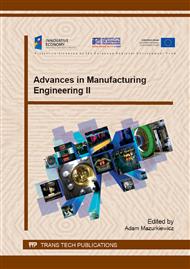[1]
K. N. Kim, M. R. Hoffman, Heterogenous photocatalytic degradation of ethylene glycol and propylene glycol, Korean Journal of Chemical Engineering, 25 (2008) 89-94.
DOI: 10.1007/s11814-008-0015-4
Google Scholar
[2]
Art. red., Właściwości fizykochemiczne płynów niezamarzających. Chłodnictwo i Klimatyzacja, 1-2 (2011) 68-69.
Google Scholar
[3]
C. Rincón, J. M. Ortiz de Zarate, J.I. Mengual, Separation of water and glycols by direct contact membrane distillation, Journal of Membrane Science, 158 (1999) 55-165.
DOI: 10.1016/s0376-7388(99)00014-9
Google Scholar
[4]
[S] Veltman, T. Schoenberg, M. Switzenbaum, Alcohol and acid formation during the anaerobic decomposition of propylene glycol under methanogenic conditions. Biodegradation, 9 (1998) 113-118.
Google Scholar
[5]
W. Jehle, T. Staneff, B. Wagner, J. Steinwandel, Separation of glycol and water from coolant liquids by evaporation, reverse osmosis and pervaporation, Journal of Membrane Science, 102 (1995) 9-19.
DOI: 10.1016/0376-7388(94)00202-a
Google Scholar
[6]
M. Szymonik, Wodne roztwory glikoli z inhibitorami. Chłodnictwo i Klimatyzacja, 1-2 (2010) 26-30.
Google Scholar
[7]
M. Woodward, A. V. Gershun, Characterization of used engine coolant by statistical analysis, Engine coolant testing, 3 (1993) 234-245.
DOI: 10.1520/stp25169s
Google Scholar
[8]
M. J. Assael, E. Charitidou, S. Avgoustiniatos, W. A. Wakeham, Absolute Measurements of the thermal conductivity of mixtures of alkene-glycols with water, International Journal of Thermophysics, 10 (1989) 1127-1140.
DOI: 10.1007/bf00500567
Google Scholar
[9]
J. Xu, C. Gao, X. Feng, Thin-film-composite membranes comparising of self-assembled polyelectrolytes for separation of water from ethylene glycol by pervaporation, Journal of Membrane Science, (352) 2010 197-204.
DOI: 10.1016/j.memsci.2010.02.017
Google Scholar
[10]
P. Łobodzin, M. Grądkowski, Dehydratation of ethylene or propylene glycol-water mixtures using ceramic membrane by prototype pervaporation installation, in: Membranes and Membrane Processes in Environmental Protection – Monographs of the Environmental Engineering Committee Polish Academy of Science, 2014, vol. 118, pp.31-37.
Google Scholar
[11]
J. Molenda, Assesment of the usefulness of inorganic sorbents in the regeneration of industrial water and glycol-based antifreezes, Maintenance Problems, 3 (2014) 101-112.
Google Scholar


